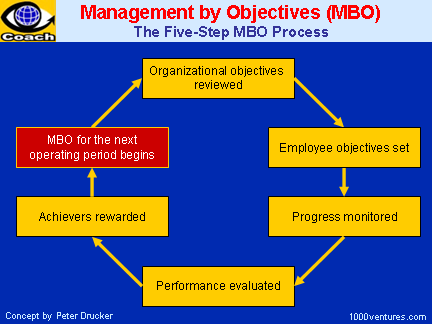
What is MBO?
Management by objectives (MBO) is a systematic and organized approach that allows management to focus on achievable goals and to attain the best possible results from available resources.
It aims to increase organizational performance by aligning goals and subordinate objectives throughout the organization. Ideally, employees get strong input to identify their objectives, time lines for completion, etc. MBO includes ongoing tracking and feedback in the process to reach objectives.
Management by Objectives (MBO) was first outlined by Peter Drucker in 1954 in his book 'The Practice of Management'. In the 90s, Peter Drucker himself decreased the significance of this organization management method, when he said: "It's just another tool. It is not the great cure for management inefficiency... Management by Objectives works if you know the objectives, 90% of the time you don't."
From MBO (Management by Objectives) to LFA (Logical Framework Approach)
The objectives and activities has always had a central role in project management. What you want to achieve and what you do to manage your goals. As long as you work alone, you can mix it all up, but in cooperation with other people and organizations, you have to communicate what you want, if you want others to do it with a result that you want and perhaps also in your way. You express goals and methods.
You express what you want, when you want things to be ready, what you want to pay for the job, who you want to be responsible and so on. All this can be arranged in systematic plans where activities and deadlines are expressed in a network. You call it Network Planning. The method was innovated during the construction of the first nuclear submarine. It has been adopted in most of all complicated projects since then.
Focusing on objectives gives the freedom for all involved to manage their activities in their own way. It is a result oriented management method. But the manager needs to formulate well defined goals and follow them up. It is not that easy. The taxonomy to write goals has been developed by Bloom and Mager has defined more in detail how to express goals to make them functional.
SMART GOALS ARE:
Specific= Significant, Stretching, Simple
Measurable= Meaningful, Motivational, Manageable
Attainable= Appropriate, Achievable, Agreed, Assignable, Actionable, Action-oriented, Ambitious
Relevant= Realistic, Results/Results-focused/Results-oriented, Resourced, Rewarding
Time-bound= Time framed, Timed, Time-based, Timeboxed, Timely, Timebound, Time-Specific, Timetabled, Trackable, Tangible
The essence of MBO, management by objectives, is participative goal setting, choosing course of actions and decision making. An important part of the MBO is the measurement and the comparison of the employee’s actual performance with the standards set. Ideally, when employees themselves have been involved with the goal setting and the choosing the course of action to be followed by them, they are more likely to fulfill their responsibilities.
The Logical Framework Approach is a method to construct goal networks, where you can be rather sure of to reach many different goals, if you just reach some well defined goals, called indicators. It simplifies the follow up work. The crucial point is not only to formulate main goals, but also to look at the relations between goals at the same hierarchic levels.
The Apprechiative Incentive is a method where you look more for possibilities than problems. You look for what already functions and try to utilize this for further development. This method was combined with Logical Framework Approach to avoid a too big problem focus and too much change for nothing.
The constructivism is based on the same philosophy, to start from that specific knowledge and experience you have and go further to the skill and knowledge you need from that point.
In our project, we need to look for such experience and adapt the concept we have developed as well as production and lerning methods to the individual and local reality.
Finally, a phase oriented approach can be helpful. Instead of doing everything at the same time, it is possible to divide the work into smaller parts, functioning separately and together. In that way you can test strategies in one phase for the next one. In our case we started to produce a smaller amount of units. We called it a pilot project.
An example to illustrate the idea better: If you want to build 15 houses and have a limited amount of money, it is better to build them one by one or maybe five by five, than to build them all at the same time and in the end find that there is a lack of money for the roofs. Without roofs no house will function. A smaller number of houses with roofs will at least function even if some houses never were constructed according to the initial plan.
It is also easier to change the plans, adapt to changed circumstances and incorporate new ideas during the project with a phase oriented process and it is possible to learn how to do the work better from one phase to the other. It is the basics in Learning by doing, the concept we are working with.
No comments:
Post a Comment